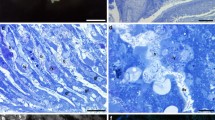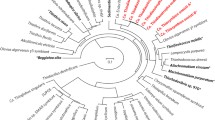Abstract
Certain hydrothermal vent invertebrates, e.g. Riftia pachyptila and Calyptogena magnifica, are clearly established as harboring dense populations of chemoautotrophic sulfur bacteria in specialized tissues. By contrast, the physiological characteristics of the abundant intracellular gill symbiont of the vent mussel Bathymodiolus thermophilus have been questioned. The low activities of enzymes diagnostic for CO2 fixation (Calvin cycle) and for sulfur-driven energy generation, as measured by other investigators, have been attributed to bacterial contamination of the gill surface. Based on research at the Galápagos Rift hydrothermal vents in 1988 and subsequent laboratory experiments, the current study confirms that the B. thermophilus symbiont is a psychrophile for which thiosulfate and sulfide stimulate CO2 fixation. It strongly indicates that the symbiont is a chemoautotroph by establishing the following: (1) Sulfide and thiosulfate can stimulate CO2 fixation by partially purified symbionts by up to 43-fold and 120-fold, respectively; (2) the ribulose-1,5-bisphosphate carboxylase/oxygenase activity of the symbiont is sufficient to account for its sulfide- or thiosulfate-stimulated CO2 incorporation; (3) the symbiont's molar growth yield on thiosulfate, as judged by CO2 incorporation, is indistinguishable from that of free-living chemoautotrophs. Due to the high protein-degrading activity of B. thermophilus gill lysate, it is also suggested that host lysis of symbionts plays a more important role in the nutrition of the vent mussel than in R. pachyptila or C. magnifica, for which no comparable protein-degrading activity was found.
Similar content being viewed by others
References
Almgren T, Hagström A (1974) The oxidation rate of sulfide in sea-water. Wat Res 8:395–400
Anderson AE, Childress JJ, Favuzzi JA (1987) Net uptake of CO2 driven by sulphide and thiosulphate oxidation in the bacterial symbiont-containing clam Solemya reidi J. exp Biol 133:1–31
Belkin S, Nelson DC, Jannasch HW (1986) Symbiotic assimilation of CO2 in two hydrothermal vent animals, the mussel Bathymodiolus thermophilus and the tube worm Riftia pachyptila. Biol Bull mar biol Lab. Woods Hole 170:110–121
Bradford MM (1976) A rapid and sensitive method for the quantitation of microgram quantities of protein utilizing the principle of protein-dye binding. Analyt Biochem 72:248–254
Brock TD, Brock ML, Bott TL, Edwards MR (1971) Microbial life at 90°C: the sulfur bacteria of Boulder Spring. J Bact 88: 1755–1761
Cavanaugh CM (1983) Symbiotic chemoautotrophic bacteria in marine invertebrates from sulphide rich habitats. Nature, Lond 302:58–61
Cavanaugh CM, Gardiner SM, Jones ML, Jannasch HW, Waterbury JB (1981) Procaryotic cells in the hydrothermal vent tube worm Riftia pachyptila Jones: possible chemoautotrophic symbionts. Science, NY 213:340–342
Childress JJ, Fisher CR (1992) The biology of hydrothermal vent animals: physiology, biochemistry and autotrophic symbioses. Oceanogr mar Biol A Rev 30:337–441
Felbeck H, Childress JJ, Somero GN (1981) Calvin-Benson cycle and sulphide oxidation enzymes in animals from sulphide-rich habitats. Nature, Lond 293:291–293
Fiala-Médioni A, Métivier C (1986) Ultrastructure of the gill of the hydrothermal vent bivalve Calyptogena magnifica, with a discussion of its nutrition. Mar Biol 90:215–222
Fiala-Médioni A, Métivier C, Herry A, Le Pennec M (1986) Ultrastructure of the gill of the hydrothermal-vent mytilid Bathymodiolus sp. Mar Biol 92:65–72
Fisher CR (1990) Chemoautotrophic and methanotrophic symbioses in marine invertebrates. Rev aquat Sciences 2:399–436
Fisher CR, Childress JJ, Arp AJ, Brooks JM, Distel D, Dugan J, Felbeck H, Fritz LW, Hessler R, Johnson KS, Kennicut MC II, Lutz RA, Macko SA, Newton A, Powell MA, Somero GN, Soto T (1988a) Variation in the hydrothermal vent clam, Calyptogena magnifica, at the Rose Garden vent on the Galapagos spreading center. Deep-Sea Res 35:1811–1831
Fisher CR, Childress JJ, Arp AJ, Brooks JM, Distel D, Favuzzi JA, Felbeck H, Hessler R, Johnson KS, Kennicut MC II, Macko SA, Newton A, Powell MA, Somero GN, Soto T (1988b) Microhabitat variation in the hydrothermal vent mussel, Bathymodiolus thermophilus, at the Rose Garden vent on the Galapagos Rift. Deep-Sea Res 35:1769–1791
Fisher CR, Childress JJ, Arp AJ, Brooks JM, Distel D, Favuzzi JA, Macko SA, Newton A, Powell MA, Somero GN, Soto T (1988c) Physiology, morphology and biochemical composition of Riftia pachyptila at Rose Garden in 1985. Deep-Sea Res 35:1745–1758
Fisher CR. Childress JJ, Oremland RS, Bidigare RR (1987) The importance of methane and thiosulfate in the metabolism of the bacterial symbionts of two deep-sea mussels. Mar Biol 96:59–71
Glauert AM (1974) Practical methods in electron microscopy. Vol. 3. Elsevier, New York
Hagström A (1984) Aquatic bacteria: measurements and significance of growth. In: Klug MJ, Reddy CA (eds) Current perspectives in microbial ecology. American Society for Microbiology, Washington, pp 495–501
Hobbie JE, Daley RJ, Jasper S (1977) Use of Nuclepore filters for counting bacteria by epifluorescence microscopy. Appl envirl Microbiol 33:1225–1228
Kelly DP (1982) Biochemistry of the chemolithotrophic oxidation of inorganic sulphur. Phil Trans R Soc (Ser B) 298:499–528
Kenk VC, Wilson BR (1985) A new mussel (Bivalvia, Mytilidae) from hydrothermal vents in the Galapagos Rift zone. Malacologia 26:253–271
Kramer M, Cypionka H (1989) Sulfate formation via ATP sulfurylase in thiosulfate- and sulfite-disproportionating bacteria. Archs Microbiol 151:232–237
Nelson DC, Jørgensen BB, Revsbech NP (1986) Growth pattern and yield of a chemoautotrophic Beggiatoa sp. in oxygen-sulfide microgradients. Appl envirl Microbiol 52:225–233
Nelson DC, Waterbury JB, Jannasch HW (1982) Nitrogen fixation and nitrate utilization by marine and freshwater Beggiatoa. Archs Microbiol 133:172–177
Nelson DC, Williams CA, Farah BA, Shively JM (1989) Occurrence and regulation of Calvin cycle enzymes in non-autotrophic Beggiatoa strains. Archs Microbiol 151:15–19
O'Brien J, Vetter RD (1990) Production of thiosulphate during sulphide oxidation by mitochondria of the symbiont-containing bivalve Solemya reidi. J exp Biol 149:133–148
Pierce JW, McCurry SD, Milligan RM, Tolbert NE (1982) Activation and assay of ribulose-1,5-bisphosphate carboxylase/oxygenase. In: Wood WA (ed) Methods in enzymology. Vol. 89. Academic Press, New York, pp 47–55
Powell MA, Somero GN (1986a) Adaptations to sulfide by hydrothermal vent animals: sites and mechanisms of detoxification and metabolism. Biol Bull mar biol Lab, Woods Hole 171:274–290
Powell MA, Somero GN (1986b) Hydrogen sulfide oxidation is coupled to oxidative phosphorylation in mitochondria of Solemya reidi. Science, NY 233:563–566
Ruby EG, Jannasch HW (1982) Physiological characteristics of Thiomicrospira sp. strain L-12 isolated from deep-sea hydrothermal vents. J Bact 149:161–165
Somero GN, Childress JJ Anderson AE (1989) Transport, metabolism and detoxification of hydrogen sulfide in animals from sulfide rich marine environments. Rev aquat Sciences 1:591–614
Wilmot DB, Vetter RD (1992) Oxygen- and nitrogen-dependent sulfur metabolism in the thiotrophic clam Solemya reidi. Biol Bull mar biol Lab, Woods Hole 182:444–453
Author information
Authors and Affiliations
Additional information
Communicated by M. F. Strathmann, Friday Harbor
Rights and permissions
About this article
Cite this article
Nelson, D.C., Hagen, K.D. & Edwards, D.B. The gill symbiont of the hydrothermal vent mussel Bathymodiolus thermophilus is a psychrophilic, chemoautotrophic, sulfur bacterium. Marine Biology 121, 487–495 (1995). https://doi.org/10.1007/BF00349457
Received:
Accepted:
Issue Date:
DOI: https://doi.org/10.1007/BF00349457




